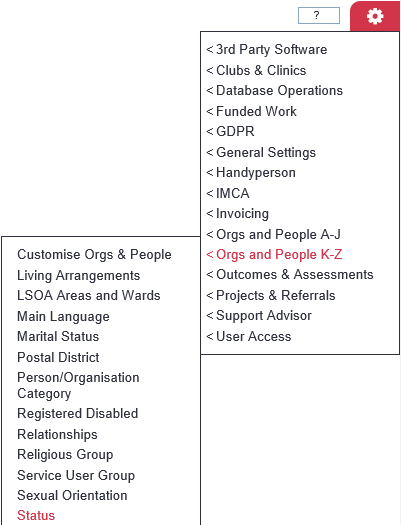Difference between revisions of "Statuses"
(Created page with "right") |
|||
| Line 1: | Line 1: | ||
[[File:helpheader_small.png|right]] | [[File:helpheader_small.png|right]] | ||
| + | ''Location in standard build:'' '''''Administration > [[Drop-Down Lists]] > Statuses (Orgs & People)''''' | ||
| + | |||
| + | [[File:Status_1.png|border]] | ||
| + | |||
| + | |||
| + | The list of Statuses is used when users enter a Status for an organisation/person on the system. The list can be anything you want it to be. The example here shows the list being used to store data about whether someone is a member or not. | ||
| + | |||
| + | [[File:Status_2.png|border]] | ||
| + | |||
| + | |||
| + | |||
| + | __TOC__ | ||
| + | |||
| + | |||
| + | |||
| + | ==Creating or editing Statuses== | ||
| + | |||
| + | Click on the menu item to see the list of Statuses that are already set up on your system, if there are any. Click "Enter New Record" to add a new one, or click the name of an existing one to edit it. | ||
| + | |||
| + | [[File:Status_3.png|border]] | ||
| + | |||
| + | |||
| + | You can now enter the following information: | ||
| + | |||
| + | * Name (of the Status) | ||
| + | * Details (for information on this screen only; these details are not output on any reports) | ||
| + | * [[Display Order]] | ||
| + | * Active? - whether the Status is available on the system or not | ||
| + | |||
| + | Click "Save Details" when you have entered the information. | ||
| + | |||
| + | [[File:Status_4.png|border]] | ||
| + | |||
| + | |||
| + | ==Examples of use== | ||
| + | |||
| + | The list of Statuses can be used for anything you need it for. Note, however: | ||
| + | |||
| + | * An organisation/person can only have one Status at a time. | ||
| + | * A record is kept of when Statuses were changed for orgs/people, and which user made the change, so this can be very useful for historical reporting. | ||
| + | |||
| + | |||
| + | ==Reporting outputs== | ||
| + | |||
| + | Information entered using the Status drop-down list is available: | ||
| + | |||
| + | * On the [[Status Report]] (this is the report which shows status changes with dates and the user that made the change) | ||
| + | * In the KPI Report Designer as a filter (e.g. the Number of Clients Accessing Service By Status report. Note that this report uses the Status of the org/person at the time the report is run, not at the time of the action) | ||
| + | * On Data Extractions, both as selection criteria and as data to be output on a spreadsheet | ||
| + | |||
| + | |||
| + | ---- | ||
| + | |||
| + | [[User:Rob Kay|Rob Kay - manual author]] ([[User talk:Rob Kay|talk]]) 13:39, 5 May 2015 (BST) | ||
Revision as of 12:39, 5 May 2015
Location in standard build: Administration > Drop-Down Lists > Statuses (Orgs & People)
The list of Statuses is used when users enter a Status for an organisation/person on the system. The list can be anything you want it to be. The example here shows the list being used to store data about whether someone is a member or not.
Creating or editing Statuses
Click on the menu item to see the list of Statuses that are already set up on your system, if there are any. Click "Enter New Record" to add a new one, or click the name of an existing one to edit it.
You can now enter the following information:
- Name (of the Status)
- Details (for information on this screen only; these details are not output on any reports)
- Display Order
- Active? - whether the Status is available on the system or not
Click "Save Details" when you have entered the information.
Examples of use
The list of Statuses can be used for anything you need it for. Note, however:
- An organisation/person can only have one Status at a time.
- A record is kept of when Statuses were changed for orgs/people, and which user made the change, so this can be very useful for historical reporting.
Reporting outputs
Information entered using the Status drop-down list is available:
- On the Status Report (this is the report which shows status changes with dates and the user that made the change)
- In the KPI Report Designer as a filter (e.g. the Number of Clients Accessing Service By Status report. Note that this report uses the Status of the org/person at the time the report is run, not at the time of the action)
- On Data Extractions, both as selection criteria and as data to be output on a spreadsheet
Rob Kay - manual author (talk) 13:39, 5 May 2015 (BST)

